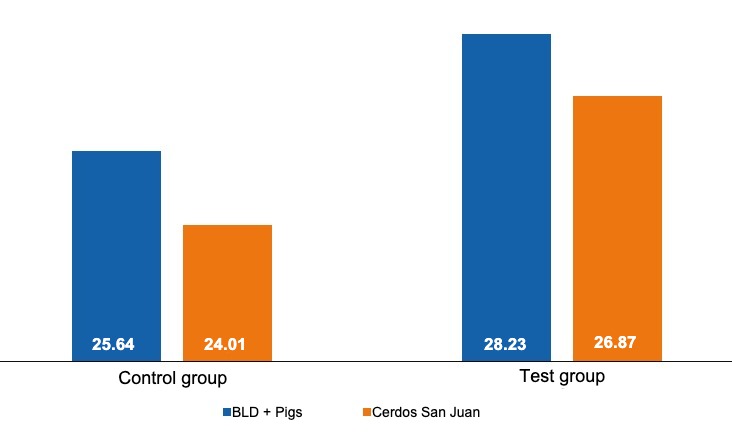The global swine industry is a dynamic, constantly advancing sector. One of the most outstanding aspects of this progress is the excellent work done by genetic companies in significantly increasing sow productivity, as evidenced by the increase in the total number of piglets born and, consequently, in the number of piglets weaned.
The challenge of porcine colostrum
These developments also pose new challenges, especially regarding the most important superfood on the farm: porcine colostrum. Several studies have shown that the amount of colostrum produced by a sow is limited, ranging from 3 to 6 kilograms, and cannot be significantly modified.

With the increase in the number of piglets born per farrowing, competition among piglets for a sufficient amount of colostrum intensifies, putting their health, survival, and future development at risk.
The importance of practical and cost-effective monitoring tools
Faced with this situation, we saw the need to evaluate whether improving colostrum quality through specific nutritional strategies is possible. It was crucial to develop and validate practical and low-cost techniques to measure colostrum quality on commercial farms.
One of the techniques employed was using digital refractometers, which, through Brix degrees, allow indirect measurement of immunoglobulin concentration. This method is fast, economical, practical, and efficient, and provides results in less than 40 seconds.

Photo 1. Use of digital refractometers for indirect measurement of immunoglobulin concentration.
In addition, it was essential to establish reference values that would differentiate good-quality colostrum from poor-quality colostrum. Our studies and those conducted by Hasan et al. (2016) determined that adequate colostrum should contain at least 50 mg/ml of IgG in its early phase (within two hours after farrowing). This author also correlated the values obtained by ELISA technique with those of the digital refractometer, and proposed intervals based on Brix readings to classify colostrum quality.
Table 1. Immunoglobulin G (IgG) content in colostrum according to two evaluation methods and estimation categories.
| Brix, % | ELISA IgG* | SEM | IgG - categories |
|---|---|---|---|
| < 20 | 14.50 | 1.80 | Poor |
| 20 to 24 | 43.80 | 2.30 | Limited |
| 25 to 29 | 50.70 | 2.10 | Adequate |
| > 30 | 78.60 | 8.40 | Very good |
*Samples taken 0 to 3 hours postfarrowing, mg/ml.
Adapted from Hasan et al., 2016.
Applied on-farm research: Improving colostrum through nutrition
Two trials were conducted in collaboration with commercial farms in Argentina (BLD + Pigs and Cerdos San Juan) during December 2023 and January 2024, using gilts and multiparous sows.
Two experimental groups were established on each farm:
- Control group: sows fed with the farm's conventional nutritional routine(*).
- Test group: sows fed with the same conventional routine plus on top supplementation of a mixture of functional proteins (animal plasma) and antioxidants (vitamins, minerals, and phytogenics) during the last 10 days of gestation.
(*) Standard diets were based on corn, soybean meal, amino acids, and vitamin-mineral premixes.
Simultaneously on both farms, we observed that significantly improving colostrum quality was possible with this strategic nutrition (data not yet published by Lescano et al., 2024), as detailed in the graphs below.
Table 2. Data on mean values, P-value, CV%, and differences (%) in colostrum quality.
| Farms | Units | Control group | Test group | P-value | CV% | Differences |
|---|---|---|---|---|---|---|
| BLD + Pigs | Brix, % | 25.64 | 28.23 | 0.0387 | 15.8 | 10.10% |
| Cerdos San Juan | Brix, % | 24.01 | 26.87 | 0.0300 | 12.6 | 11.91% |
TR7 and TR13- Data from KPIs Consulting R&D&I reports.


Graph 1. Colostrum quality as a function of nutritional strategy.
Colostrum stability over time
Having demonstrated the feasibility of improving colostrum quality through nutritional strategies and in an attempt to give practical application to the research conducted, a new question arose: How long does colostrum maintain adequate quality after farrowing? To answer this question, we sampled colostrum every two hours after farrowing on several commercial farms, considering variations in genetics, nutrition, management, and feeding. We determined that after 240 minutes, the Brix degrees measured with the digital refractometer fell below 24, indicating insufficient quality according to the parameters established by Hasan (2016).
On the other hand, when we analyzed data from commercial farms, we observed that more than 40% of highly prolific sow farrowings last more than 240 minutes. This means that piglets born after this period have access to insufficient quality colostrum, which puts their survival, health, on-farm sanitary stability, and productive performance at risk.
Final considerations
Colostrum quality is a determining factor in pig production, especially in the face of challenges such as larger litters, demedicalization, the zinc oxide ban, etc. Implementing practical measurement tools and developing specific nutritional strategies represent significant advances in meeting these challenges. Continuing to research and refine these strategies will be key to maximizing colostrum performance, quality, and utilization to ensure sustainability in swine production.
Acknowledgments for the collaboration in the development of the information presented:
- BLD + Pigs - Argentina: Marco Brunori, Pablo Fraga, Nadia Kolmann, Juan Matteucci, Fatima Guzman, Sebastian Henze, Mauricio Nicollier.
- San Juan Pigs - Argentina: Abel Sanchez, Sabrina Aguilera, Rocio Mas, Pablo Santa Maria.
- KPIs Consulting: Catalina Torres, Sandra Salguero, Amanda Melo, Mariano Alonso.
- Micaela Velardez, Luciana Vera, Lourdes Henze, Veronica Rocha.



